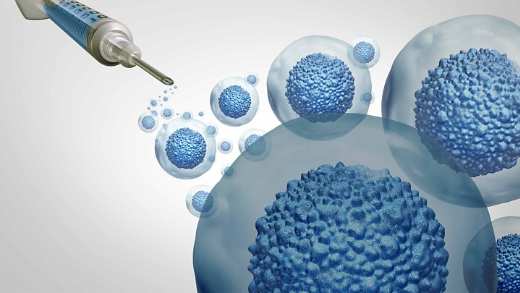Stem cell and bone marrow transplants
Stem cell and bone marrow transplants are used to treat conditions affecting blood cells.

A stem cell transplant (also known as bone marrow cell transplant) is used to treat conditions affecting the blood cells, such as leukaemia, myeloma and lymphoma.
Although the outcome of these transplants is the same (harvesting healthy cells), the procedures are different.
Stem cells are taken from the bloodstream or bone marrow from you or a donor and are used to replace damaged blood cells with healthy ones. Stem cell transplants are more common than bone marrow transplants as it is easier to collect stem cells from the bloodstream than bone marrow.
These procedures can allow a patient to endure a high dose of chemo and/or radiotherapy, to replace bone marrow not working properly or introduce stem cells that kill cancer cells directly.
Healthy blood cells transport nutrients to, and waste product away, from the body, as well as fighting infection, so a stem cell transplant is like having a new motor to do the job.
Why you’d need a stem cell or bone marrow transplant
If your bone marrow has been damaged and is no longer able to produce healthy blood cells, a stem cell transplant may be used.
A transplant can also be used to replace blood cells that have been destroyed or damaged by intensive cancer treatment.
What happens in a bone marrow and stem cell transplant procedure?
Initially you’ll be evaluated and assessed to make sure you’re physically well enough for the transplant.
Next, the stem cells are harvested from either you (autologous transplant) or the donor (allogeneic transplant). This can be in the form of blood, which is taken through an IV line and circulated through a machine separating the stem cells, or in exceptional cases by taking stem cells directly from the bone marrow.
To prepare your bone marrow for the new stem cells you’ll then receive chemotherapy and/or radiotherapy, to condition your body. This can be quite challenging and unpleasant, as you may suffer with side effects such as sickness, hair loss and tiredness.
When the conditioning treatment ends, the healthy stem cells will be infused into your body through a drip. You’ll be awake during this stage and the transfusion is painless.
The process is very intensive, and you’ll need to stay in hospital to allow the stem cells to settle in your bone marrow, divide and start to produce new stem cells.
You won’t be back on your feet straight away, but most people are well enough to go home between 1 and 3 months.
What happens in a bone marrow and stem cell transplant procedure?
Initially you’ll be evaluated and assessed to make sure you’re physically well enough for the transplant.
Next, the stem cells are harvested from either you (autologous transplant) or the donor (allogeneic transplant). This can be in the form of blood, which is taken through an IV line and circulated through a machine separating the stem cells, or in exceptional cases by taking stem cells directly from the bone marrow.
To prepare your bone marrow for the new stem cells you’ll then receive chemotherapy and/or radiotherapy, to condition your body. This can be quite challenging and unpleasant, as you may suffer with side effects such as sickness, hair loss and tiredness.
When the conditioning treatment ends, the healthy stem cells will be infused into your body through a drip. You’ll be awake during this stage and the transfusion is painless.
The process is very intensive, and you’ll need to stay in hospital to allow the stem cells to settle in your bone marrow, divide and start to produce new stem cells.
You won’t be back on your feet straight away, but most people are well enough to go home between 1 and 3 months.
Risks of a stem cell and bone marrow transplants
You may feel anxious about the risks and challenges, but if you’re in otherwise good health apart from your underlying condition, the benefits of the transplant usually outweigh the risks.
Your medical team will talk you through the risks before the transplant. The main ones are:
- GvHD – which means Graft versus Host Disease. This can happen when transplanted cells from a donor attack the other cells in the body. This doesn’t happen when using your own stem cells.
- Acute GvHD (aGvHD) is a reaction of donor immune cells against host tissues. Patients can develop a skin rash, jaundice or hepatitis of the liver and/or abdominal pain or diarrhoea. Footnote [1] In a milder form it only affects 25% of skin. Footnote [2]
- Chronic GvHD can occur after aGvHD or start at any time. It can affect any organ or system with a GvHD, but can also affect the lungs, muscles and joints.
- Infection – this can be as a result of your white blood cell count being low in the early days after the transplant.
- Anaemia – this can happen as your red blood cell count is lower after the transplant.
- Fertility can be affected and some patients opt to bank sperm or eggs before the procedure.
Recovery and side effects
While you’re in hospital the transplant team will be on the alert for any side effects and will be able to help you if you feel unwell.
Some patients experience pain in different parts of the body which can slow down your initial recovery - your medical team will be able to advise you on pain relief or refer you to a pain specialist team.
Other side effects after the stem cell transplant can include abdominal pain, tiredness, sickness, bleeding, bruising, fever or headaches.
You may be able to use your cover to pay for a stem cell or bone marrow transplant and treatment
If you are diagnosed with a condition that may require a stem cell transplant, we can help you navigate what benefits your particular policy has access to. You can update us by calling directly to our claims team or using the MyAviva portal online.
Once we’ve confirmed your claim meets the terms of your policy, we’ll pay any medical bills directly. Just be sure to tell us if you need more tests or treatment, or if your hospital or specialist changes.
It’s good to have one less thing to worry about. It takes Aviva.
Next article
Worried about GP and hospital wait times?
Here's how quickly you could get treated with health insurance.



